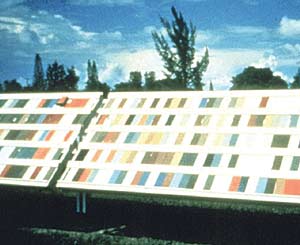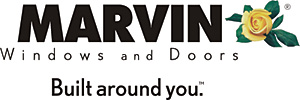AAMA 2605-05 Sets High Standards for Coated Aluminum Extrusions and Panels
 Test samples are exposed to the elements in South Florida. Photos courtesy of Marvin Windows and Doors. |
Chemical resistance. Color retention and adhesion are tested following chemical contact with five different substances. The following values are used:
Muriatic Acid: A 10 percent solution at a 15-minute exposure
Requirement: There should be no blistering or noticeable change in appearance to the naked eye. There should be no removal of the coating.
Mortar: A 24 pat test in 100 percent humidity. Wet pats of mortar two inches in area and one-half inch thick should be applied to the coated aluminum panel and immediately exposed to 100 percent humidity at 100 degrees F.
Requirement: The mortar should be able to be easily removed and the residue wiped clean with a damp cloth. There should be no loss of coating and no change in visual appearance of the sample panel.
Nitric Acid: A 30-minute test exposure to a 70 percent nitric acid solution
Requirement: No more than a prescribed amount of color change when compared to the portion of the panel unexposed to acid.
Detergent: A 30 percent detergent solution at 100 degrees F for 72 hours
Requirement: No blistering, loss of coating adhesion or change in visual appearance.
Window Cleaner: 10 drops of window cleaner applied for 24 hours
Requirement: No blistering or change in visual appearance, no removal of film under tape.
Corrosion Resistance. Blistering and seepage resulting from humidity are tested at an exposure of 4,000 hours in a controlled heat and humidity cabinet.
Requirement: No formation of more than a few blisters of a prescribed size.
Salt Spray Resistance. The coating is scored deeply enough to expose the base metal using a sharp knife or other blade instrument. The test panel is exposed for 4,000 hours using a five percent salt solution. The solution is removed, and the panel dried. Tape is applied over the scored area and sharply pulled off.
Requirement:A minimum rating of seven on cut edges and minimum blister rating of eight within the test field.
Weathering. Tests for fading, chalking, gloss, and erosion are conducted over an extended period of time. Samples are placed on a fence facing the sun and left exposed to the elements for a prescribed period of time.
South Florida Test. Sites for on-fence testing are to be a South Florida exposure south of latitude 27 degrees N and at a 45 degree angle facing south for a minimum of 10 years.
Requirement: The coating must maintain its integrity and at the least meet prescribed levels for color retention, chalk resistance, gloss retention, and erosion resistance.
Chalking: Refers to a failure of the resin which results in paint coming off the surface of a product. This is evidenced by the white power that comes off the surface, indicating the paint system is breaking down. Chalking is measured on an exposed, unwashed painted surface.
Requirement: No more than what is represented as a No. 8 rating for colors and a No. 6 for whites after exposure for 10 years. Chalking is measured on a 10 point scale. The higher the number, the better the performance.
In a comparative analysis of the test results for 70 percent PVDF application, silicone polyester, and polyester and acrylic coatings on aluminum extrusions, 70 percent PVFD offers the best choice.
|









